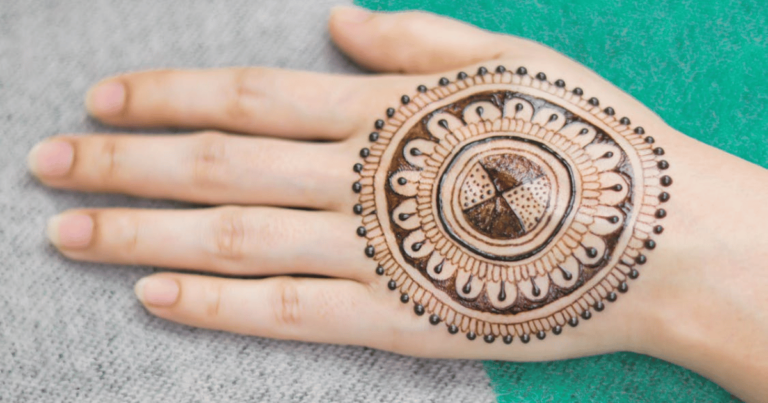Mehndi, also known as henna, is more than just a beautiful adornment—it’s an expression of culture, tradition, and artistry. Popular in South Asian, Middle Eastern, and North African communities, mehndi is often an essential part of weddings, festivals, and spiritual ceremonies. For cultural enthusiasts, brides-to-be, and anyone looking to explore this intricate art form, this blog offers a comprehensive guide.
From its fascinating history to its modern-day uses and application techniques, discover everything you need to know about mehndi!
Table of Contents
What is mehendi 101 guide?
Mehndi refers both to the art of applying henna and the dye itself, derived from the leaves of the henna plant. The leaves are dried, powdered, and mixed with water, often with a touch of lemon juice or essential oils, creating a paste that stains the skin a vibrant orange or reddish-brown.
While historically linked to countries like India, Pakistan, Morocco, and Egypt, mehndi has gained global appeal for its stunning designs and cultural significance.
History of Mehndi
Mehndi has a rich history dating back over 5,000 years:
| Region | Historical Roots |
|---|---|
| Ancient Egypt | Used to adorn mummies; henna is believed to have symbolic and spiritual meaning. |
| India | Associated with Ayurveda, often used for cooling the body and as a remedy. |
| Middle East | Popularized as a decorative art for weddings and celebrations. |
| Morocco | A symbol of protection against evil spirits and misfortune. |
Today, mehndi is an integral part of various cultures, but it also enjoys popularity among those simply looking to explore its beauty and symbolism.
The Cultural Significance of Mehndi
Mehndi is brimming with cultural and spiritual meaning. Whether it’s a wedding ceremony or a festival like Diwali or Eid, symbols drawn with henna often carry messages of joy, love, and prosperity.
- Weddings
For South Asian brides, mehndi signifies beauty, luck, and a prosperous married life. The patterns often hide the initials of the groom, making it a playful ritual to uncover during the celebrations. The darker the stain, the more auspicious it is considered!
- Festivals
Celebrations like Karva Chauth, Teej, and Eid are all incomplete without mehndi adorning hands and feet. It’s a way to mark the joy and festivity of the occasion.
- Spiritual Symbolism
Mehndi is believed to ward off evil spirits and bring good energies, making it popular for religious ceremonies too.
Popular Mehndi Designs and Their Meaning
Modern mehndi artists draw inspiration from age-old symbols and contemporary trends. Below are some popular mehndi designs and what they represent:
| Design Element | Meaning |
|---|---|
| Paisleys | Symbol of fertility and luck. |
| Floral Patterns | Represent joy and happiness. |
| Peacocks | Often associated with beauty and elegance. |
| Mandala Art | Spirituality, balance, and unity. |
| Dots and Lines | Minimalist designs focusing on symmetry and sophistication. |
Whether you’re drawn to elaborate bridal patterns or minimalist contemporary styles, there’s something for everyone.
How to Apply Mehndi Like a Pro
Want to try your hand at mehndi art? With a little practice, anyone can create stunning designs. Here’s a step-by-step guide:
- Prepare the Henna Paste
If you’re making your own, mix henna powder with lemon juice, sugar, and a drop of essential oil. Allow the paste to sit for 6–12 hours to release its dye fully.
- Choose Your Tools
Use a cone, a toothpick, or even a small plastic bag with a tiny hole in it to pipe your designs.
- Clean Your Skin
Wash your hands or feet to remove any oils or residues for better staining.
- Create a Design
Start simple by drawing dots, lines, and small floral designs. Don’t worry about perfection—practice makes perfect!
- Dry and Seal the Design
Allow the paste to dry and apply a lemon-sugar mixture on top to ensure long-lasting results.
- Scrape Off for Results
After keeping the paste on for 4–6 hours (or overnight for a darker shade), scrape it off without using water. You’ll be left with a vibrant stain that lasts for one to two weeks.
Quick Tip
For a darker stain, keep your hands warm, and avoid water contact for at least 24 hours after application.
FAQs About Mehndi
Q1. How long does mehndi last?
Typically, mehndi lasts 1–2 weeks. The intensity of the stain depends on the quality of henna and the duration it is left on the skin.
Q2. Is mehndi safe for the skin?
Natural henna is safe for most people. However, always ensure your henna is free from harmful additives like PPD (used in black henna), as it can cause allergic reactions.
Q3. Can I use mehndi for my hair too?
Absolutely! Henna doubles as a natural conditioner for hair and can also impart a reddish tint.
Q4. Can mehndi be removed quickly?
Fading mehndi naturally is the safest method, but scrubbing with oils or gentle exfoliation can speed up the lightening process.
Q5. Where can I find professional mehndi artists?
Many cities have mehndi artists who specialize in creating intricate designs. Alternatively, you can attend workshops to learn from seasoned professionals.
A Modern Mehndi Movement
While deeply rooted in tradition, mehndi has transcended cultural boundaries and become a contemporary art form. From Coachella-inspired minimalist designs to intricate bridal patterns, it’s a universal symbol of beauty and customization.
For those looking to explore or celebrate mehndi, it’s not just about wearing art—it’s about connecting with a deeper sense of culture, tradition, and personal expression.

